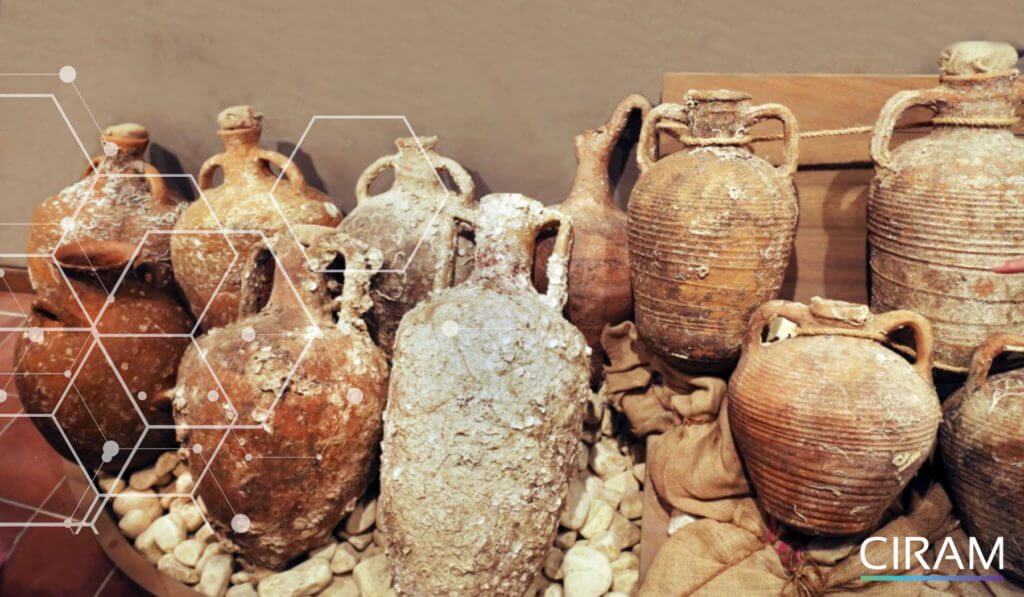Analysis of organic residues for archaeology
Analyzing organic residues for archaeology makes it possible to identify oils, fermented beverages, resins, fats, perfumes used in remote times and understand the habits and customs of ancient peoples.

Thanks to the coupling of cutting-edge technologies, such as infrared spectrometry, Raman spectrometry and chromatography, our scientists will detect and identify organic remains discovered in ancient amphorae or pottery. The techniques developed by CIRAM make it possible to characterize oils, fermented beverages, resins, fats, perfumes in order to understand the dietary and cosmetic habits of ancient peoples.
Organic residues, to understand ancient habits and practices
Organic residues found in dishes, vases or flasks are clues to food customs, ancient cooking methods for example. But they can also provide information about trade in Antiquity or the Middle Ages, as well as ancestral burial practices. CIRAM laboratories have an analytical network that will cover a wide spectrum of investigations, starting with the identification of major product families (oil, fat, resin…), right through to the discovery, in the best of cases, of ancient cooking recipes.
.
Methods for analyzing organic residues
Fourier transform infrared spectroscopy, in ATR mode or microscopy, is used to identify the major families of organic compounds. For example, we can characterize the presence of oil, animal fat or natural resin. Mineral matter, however, can provide a spurious signal, preventing identification of the organic compounds present. For this reason, infrared spectrometry will usually be used as a preliminary step. CIRAM teams will generally couple FTIR spectrometry with other analytical techniques, such as chromatography or Raman spectrometry for example.
.
GC-MS coupling to spot and identify substances
Gas chromatography (GC) coupled with mass spectrometry (MS) is the technique dedicated to the study of organic compounds. Chromatography will separate compounds from a sample, while mass spectrometry will identify compounds according to their mass. This GC-MS coupling enables the precise identification and quantification of many substances present in very small quantities, or even in trace amounts. Using GC-MS analysis, our scientists can characterize most of the molecules present in an archaeological mixture or organic residue. It’s the nature of these molecules combined with their concentration that will enable us to trace the material used, olive oil, walnut brou, animal fat, tannin…
Complementary analytical techniques for the analysis of certain residues
Although more dedicated to the study of mineral matter, Raman spectrometry is nonetheless an interesting method in archaeometry, as it is non-invasive and requires no sample pre-treatment.
This analysis provides very good spatial resolution, enabling samples to be studied on a very small scale (spot size of a few µm). Raman spectrometry can be used on its own, or in conjunction with FTIR spectrometry or GC-MS chromatography. Indeed, the residues found in ancient pottery are so complex, that it usually proves necessary to use various complementary analytical techniques.
Carpology for the study of seeds and fruits found
Carpology is the study of seed and fruit remains discovered in ancient containers or archaeological sediments. Analysis of these plant residues provides information about human activities and ancestral lifestyles. Even charred, CIRAM scientists are able to identify the nature of these seeds, and thus understand their use and reconstruct environments.
Palynology, the study of pollen and spores
Palynology is the study of pollens and spores released by plant species. Coupled with carpology and anthracology, these techniques will enable the reconstruction of environments and climates. Observations made using light microscopy or electron microscopy will make it possible to determine the dimensions and shapes of pollen grains or spores, the number and shape of apertures, ornamentation, wall structure… and thus define the plant family, genus and in the best case the species.
.
CIRAM laboratories, specialists in carbon-14 dating and archaeometric analysis.
CIRAM, specialists in carbon-14 dating and archaeomaterials analysis, offers the meticulous examination of organic residues. Committed to delivering relevant and accurate results, we interpret the results and remain at your disposal to discuss hypotheses as required.
